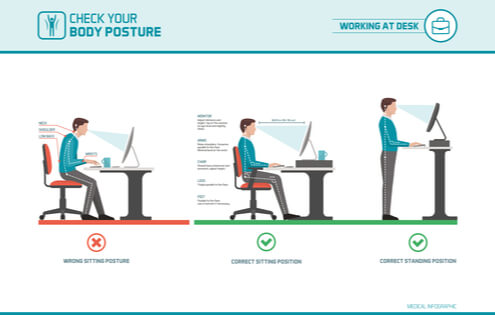Pay attention to your health and posture while you’re working from home
If you, like the majority of office workers in the UK, are currently working from home, it’s likely that you’re struggling to maintain a healthy posture throughout the day. When the coronavirus lockdown was announced at the end of March, many of us quickly cobbled together our home workstations, not really paying attention and with many of us now working from the kitchen table, it’s possible that we’re experiencing aches and pains due to not having the correct home office set up.
For the real source of this issue, we have to look at evolution. Over millennia, the human body evolved to move around rather than sit down. This means our bodies aren’t adapted for long periods of inactivity which can result in aches and pains which, if continued over time, can develop into serious health conditions.
With no definite date from the government for when we can safely return to work at the office, it’s more important now than ever to upgrade our home office equipment to include sufficient ergonomic furniture which is designed to take the human frame into account. For some of us, this could mean investing in an ergonomic chair. These have been around for many years as a response to the increased awareness of the dangers of sitting down incorrectly. They cleverly enable us to alter the height, angle and depth of our chairs so that we sit in line with our desk, and minimise the strain we put on our back, neck, shoulders and arms.
When you’ve chosen the right chair, it will be time to consider the options for your workstation desk. This should be sturdy and customisable with as many features as you can afford. The king of all desks are the ergonomic sit-stand, height-adjustable desks which have gained popularity over the past few years due to their functionality which allows users to vary the way they work throughout the day.

By pressing one button on the desk, within seconds you can change between sitting and standing and therefore, incorporate more movement into your working day, making you happier, healthier and more productive while you work from home and less likely to encounter posture problems.
Common health and posture problems caused by poor desk positioning
- Shoulder and neck – When you’re engrossed in a work task, time tends to fly by and it’s not until you stand up or stretch out that you realise just how stiff you’ve become. The most common and discussed negative physical side effect of bad desk posture is soreness and pain in the back and shoulders. By holding your body in this unnatural position, it puts excess strain and tension on these areas.
- Headache – Poor posture can also be responsible for headaches, because of the tension carried in the shoulders, back and neck areas. The best way to avoid posture headaches is to change position as much as possible, which is where height-adjustable desks come into their own.
- Digestive health – You wouldn’t normally associate poor posture with stomach problems, but when you slouch forward for long periods of time, you’ll compress your abdomen which cannot do its job properly as a consequence. You’re therefore likely to develop stomach issues like acid reflux and heartburn as a result.
- Reduced mobility – Slouching all day while you work will result in decreased flexibility and limit the range of motion in your neck and back.
- Repetitive Strain injury – Maintaining a poor or awkward posture or position for a long time without rest is recognised as a cause of RSI. Other factors are too fast or excessive workloads, long hours and lack of breaks.
Tips for improving desk posture
UK employers have a responsibility of care towards their staff “to ensure that seating is safe and that it does not pose a health risk to employees, or to others who may use their premises”. There is no official advice yet about the use of sit-stand desks, but there is plenty of scientific evidence to suggest that, used properly, they will have positive benefits on posture.
Keeping moving is a good way of helping to mitigate the effects working at a desk can have on posture. Some sit-stand desks can be linked to an app that will send reminders to change the desk height for optimum benefit.
The NHS website has a helpful list of exercises employees can do at home to help correct poor posture, increase muscle strength and reduce the dangers of longer-term health problems. Other exercises that help posture include the Alexander Technique, Pilates and Yoga.





